
The term "buddha" literally means "awakened
one" or "enlightened one". The original name is (Sanskrit) Gautama
, or (Pali) Gotama , also called Siddhartha founder of Buddhism,
the predominant religious and philosophical system of much of Asia.
He was born about 560 BC and died about 480. At the core of the
Buddha's enlightenment was the realization of the Four Noble Truths:
- Life is suffering.
- All suffering is caused by ignorance of the nature of reality
and the craving, attachment, and grasping that result from such
ignorance.
- Suffering can be ended by overcoming ignorance and attachment.
- The way/Path to the suppression of suffering is the Noble
Eightfold Path which leads to Nirvana (disinterested wisdom and
compassion).
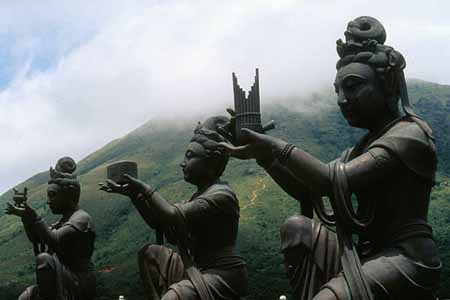
Buddhism is religion and philosophy that developed
from the teachings of the Buddha Gautama (or Gotama), who lived
as early as the 6th century BC.

Soon after Buddhism was founded appeared sanghis
which were communes of monks who ordered and organized the anarchic
way of living of first Buddha's followers. The sanghi changed into
a religious organization with time. Its role was very vital when
temples became permanent residences for monks. Monks were also religious
tutors. A monk who took the salvation path and, therefore, had a
celestial aura, was of really great significance...
Are you surprised that I have started the article
like this? Because along with three well known world religions there
is one more, which however concerns only PC users; this is asustekism,
or asusism, to you liking, where ASUSTeK takes the place of Buddha.
Why is it so? It's simple. This popular Taiwanese
company was well known when the word "upgrade" was still timid or
rare, and and computers were just becoming personal. At that time
users preferred to buy "486dx2-66/16/140/SVGA/1 MBytes/" than to
assemble machines themselves. And that wave brought us famous 486
mainboards on the SIS496 chipset. This is how ASUSTeK got famous.
But time passed, and the star of ASUSTeK rose very
high. Yet some time ago its products differed from others in quality,
interesting innovations and technologies, but today the star is
fading to some reason. And only fabulous prices differ ASUSTeK products
from others.
I won't touch upon mainboards or other spheres
of the company as we are dealing only with video cards. When a year
ago the company entered the GeForce3 market its products were really
unique! Now we can see that the Titanium series of ASUSTeK are the
same as the previous releases, and only prices are higher, and the
GeForce4 MX cards look paler even than their competitors though
they are dearer.
For last two years many companies started paying
much more attention to what they are producing, and now they have
caught up with ASUSTeK from reliability standpoint. They are such
companies as Leadtek, Gainward, SUMA and others. But ASUS has still
overpriced products.
However, it concerns only Eastern Europe, because
according to PriceWatch, in USA ASUSTeK is available at almost the
same prices. Lots of vendors today try to do their business profitable
at the expense of selling their products under the ASUS trade mark,
and first of all, it concerns video cards and mainboards.
Isn't it an idol? Yes! When there are companies
which produce goods not worse (for example, GeForce4 Ti 4600 and
cards on it from Chaintech or Gainward), when cards and packages
look more attractive - many still pull faces saying that it's not
Asus. And the fact the Ti 4600 from such companies is almost equal
in price with what we had with the Ti 4400 from ASUS doesn't matter
for anybody.
I want to ask vendor s not to worship ASUS anymore
and pay more attention to other companies. Besides, I want to reproach
ASUSTeK for its doing nothing to prove such high prices. I suggest
that you turn to others, for example, ChainTech or Hercules. But
I don't mean change an idol. Everyone has its weak and strong sides.
And do remember that every company has good and bad solutions, and
you shouldn't retain only bad ones for the whole life.
I'm not going to find fault with ASUSTeK, but it's
clear that its video front has weakened, the company is almost the
last to release new products. I just want to understand why this
sector is not favorite any more for the company. And I want to warn
that it's dangerous to rest on its laurels today. (just remember
Matrox Graphics).
Nevertheless, we will take a look at two new products
from ASUSTeK, the most powerful pair of Ti 4400/4600.
But first of all, look at the articles related
with the GeForce4 Ti line.
Theoretical materials and reviews of video cards
which concern functional properties of the NVIDIA GeForce4 Ti GPU
Today we will continue to estimate how the 3D speed
depends on a CPU frequency in 3DMark2001SE in all stands available
in our lab.
So, in the lab we have ASUS V8440 and V8460Ultra.
Cards
Both cards have an AGP x2/x4 interface, 128 MBytes
DDR SDRAM located in 8 chips on both sides of the PCB.
| ASUS V8440 (GeForce4 Ti 4400)
/ ASUS V8460Ultra (GeForce4 Ti 4600) |

|
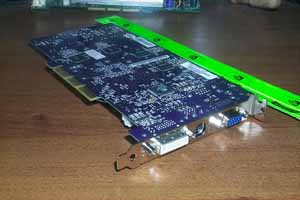
|
| ASUS V8440 (GeForce4 Ti 4400) |
| The Samsung 3.6ns memory chips correspond to
275 (550) MHz at which the memory works. The GPU runs at the
Ti 4400's speed of 275 MHz. |
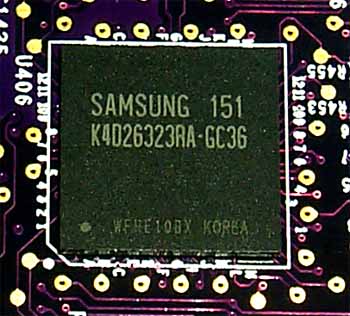
|
| ASUS V8460Ultra (GeForce4 Ti 4600) |
| The Samsung 2.8ns memory chips correspond to
357 (714) MHz. Thecard runs at the frequencies rated for Ti
4600 - 300/325 (650) MHz. |
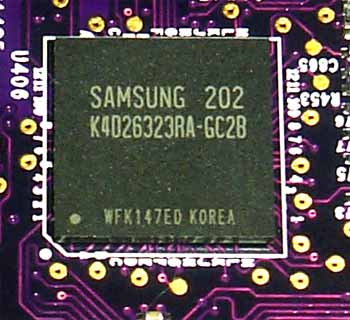
|
| Comparison with the reference
design, front view |
| ASUS V8440 (GeForce4 Ti 4400) |
Reference card NVIDIA GeForce4 Ti 4400 |

|
 |
| ASUS V8460Ultra (GeForce4 Ti 4600) |
Reference card NVIDIA GeForce4 Ti 4600 |
 |
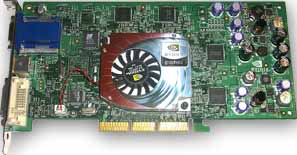
|
| Comparison with the reference
design, back view |
| ASUS V8440 (GeForce4 Ti 4400) |
Reference card NVIDIA GeForce4 Ti 4400 |
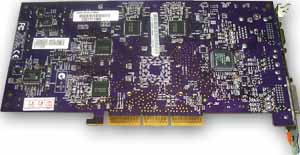
|
 |
| ASUS V8460Ultra (GeForce4 Ti 4600) |
Reference card NVIDIA GeForce4 Ti 4600 |
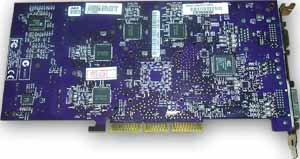
|
 |
Note that there is only one modification - V8460Ultra,
and there is no the card without "Ultra" in its name. Maybe this
suffix appeared because the company wanted to released a card working
on higher frequencies (330/330 (660) MHz) than cards of other firms,
but our investigation showed that all chips released before March
2002 had quite low overclockability.
Both cards are copies of the reference samples.
The PCB is purple which is not typical of ASUS. Besides, the cooler
is quite unusual. I haven't seen yet a fan looking like a turbine.
That is why such cooler is very heavy although it is made of aluminum.
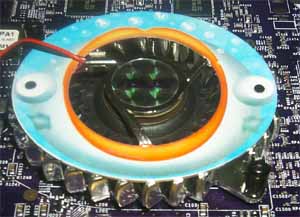
Look at what is shown on the heatsink! It's interesting
what they were thinking about when drew that :-)

On the one hand, such a colorful device attracts
attention, on the other hand, it looks so cheap-bright for a High-End
product.
What I have just said concerns both cards because
they differ only in a couple of capacitors on the PCB. The main
differences are between the memory chips and the GPU (Ti 4400 above,
Ti 4600 below):
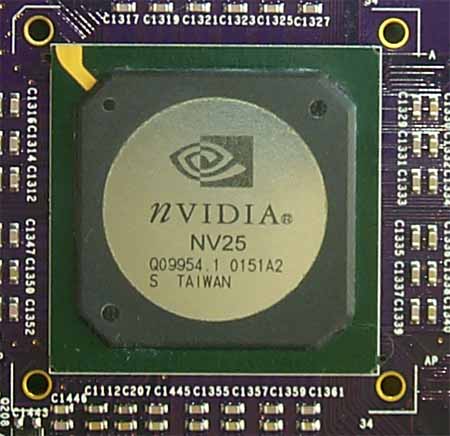
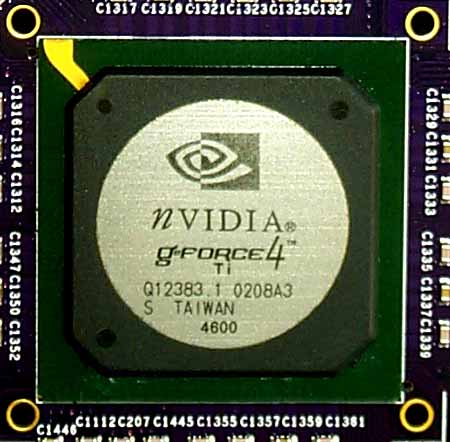
The ASUS V8460Ultra has GeForce4 Ti 4600 chip produced
in the beginning of March and which doesn't have a codename but
a marking, besides, there is a new stepping A3 (revision). I don't
know what the A3 differs from the A2 in. I just can state that the
A3 provides better overclocking potential (but it proved to be so
only in the tests of two cards with the A3 revision of the GeForce4
Ti 4600 chip).
Both cards have DVI and d-Sub unsoldered. Two CRT
monitors can be connected with DVI-to-VGA adapter which is included
into the package. Both cards have a TV-out realized through the
Conexant codec:
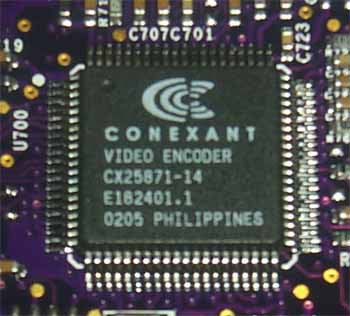
TV-out quality was already estimated earlier (see
the list above).
Now let's see what they cards come with.
| ASUS V8440 (GeForce4 Ti 4400) |
| Here we have a user manual (several loose leaves,
though some time ago it was a book of excellent quality),
a CD with drivers and utilities, QuadForce games (AquaNox,
Midnight GT Rage Rally, demo versions of 5 mode games), a
CD with a program DVD player ASUS DVD 2000, a DVI-to-VGA adapter,
an S-Video-to-RCA adapter. |
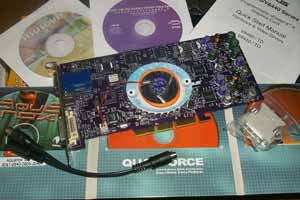
|
| ASUS V8460Ultra (GeForce4 Ti 4600) |
| All the same. |
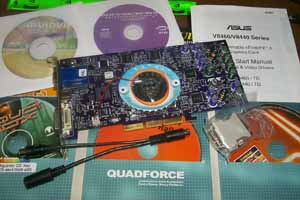
|
Both cards come in a retail package.
| ASUS V8440 (GeForce4 Ti 4400) |
| In general, the design is old; on the left
is the ASUS's mark, and on the right is an image which is
Pegus probably symbolizing easy flight in a 3D space. |
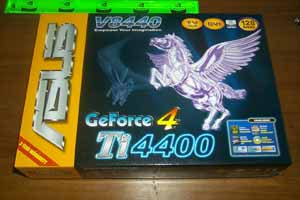
|
| ASUS V8460Ultra (GeForce4 Ti 4600) |
| Well, there are only two differences: above
where is the card's name and below where there is the chipset's
name. |
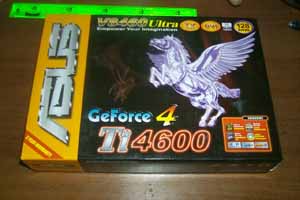
|
That's all I had to say about peculiarities of the cards.
Overclocking
| ASUS V8440 (GeForce4 Ti 4400) |
275/550 -> 320/680 MHz |
| ASUS V8460Ultra (GeForce4 Ti 4600) |
300/650 -> 335/750 MHz |
The A3 revision gives excellent overclocking potential;
it's the first time when the GeForce4 Ti 4600 works so stably at
such high frequencies. The ASUS V8440 achieved also good results.
These overclocking results will appear in our April's 3Digest.
Note:
- in course of overclocking you must provide additional cooling,
in particular, for the card (first of all, for its memory):

- overclocking depends on a definite sample, and you shouldn't
generalize the results of one card to all video cards of this
mark or series. The overclocking results are not the obligatory
characteristics of a video card.
Test system and drivers
This time we estimated how performance of the accelerator
depended on a CPU frequency (and on a platform), that is why we
used several testbeds:
- Pentium 4 2200 MHz based computer:
- Intel Pentium 4 2200 (L2=512K);
- ASUS P4T-E (i850) mainboard;
- 512 MBytes RDRAM PC800;
- Quantum FB AS HDD, 20 GBytes;
- Windows XP.
- Pentium 4 2000 MHz based computer:
- Intel Pentium 4 2000 (L2=512K);
- ASUS P4T-E (i850) mainboard;
- 512 MBytes RDRAM PC800;
- Quantum FB AS HDD, 20 GBytes;
- Windows XP.
- Pentium III 1000 MHz based computer:
- Intel Pentium III 1000 MHz (133 MHz x 7.5)
- Chaintech 6OJV2 (i815E) mainboard;
- 256 MBytes SDRAM PC133;
- Seagate Barracuda IV HDD, 40 GBytes;
- Windows XP.
- Athlon XP 1666 MHz (2000+) based computer:
- AMD Athlon XP 2000+
- EPoX 8KHA+ (VIA KT266A) mainboard;
- 512 MBytes DDR SDRAM PC2100;
- Fujutsu HDD, 20 GBytes;
- Windows XP.
- Athlon XP 1250 MHz based computer:
- AMD Athlon XP 1250 MHz (100 MHz x 12.5)
- EPoX 8KHA+ (VIA KT266A) mainboard;
- 512 MBytes DDR SDRAM PC2100;
- Fujutsu HDD, 20 GBytes;
- Windows XP.
- Athlon 1000 MHz based computer:
- AMD Athlon 1000 MHz (133 MHz x 7.5)
- ABIT KT7E (VIA KT133A) mainboard;
- 256 MBytes SDRAM PC133;
- Fujutsu HDD, 20 GBytes;
- Windows XP.
- Athlon 750 MHz based computer:
- AMD Athlon 750 MHz (100 MHz x 7.5)
- ABIT KT7E (VIA KT133A) mainboard;
- 256 MBytes SDRAM PC133;
- Fujutsu HDD, 20 GBytes;
- Windows XP.
The test system was coupled with ViewSonic P810
(21") and ViewSonic P817 (21") monitors.
In the tests we used NVIDIA's drivers of v28.32.
VSync was off, S3TC was off.
For the comparative analyses we used the following
cards:
- ABIT Siluro GF3 Ti500 (NVIDIA GeForce3 Ti 500, 240/250 (500)
MHz, 64 MBytes);
- ATI RADEON 8500 (RADEON 8500, 275/275 (550) MHz, 64 MBytes,
driver 6.052);
- Joytech Apollo Devil Monster II RADEON 8500 (RADEON 8500LE,
250/250 (500) MHz, 128 MBytes, driver 6.052, overclocked to
275/275 (550) MHz).
Test results
The 2D quality is superb, no problems at 1600x1200x85
Hz.
For estimation of 3D quality we used:
- 3DMark2001 SE (MadOnion) -a synthetic test which demonstrates
operation of a card in DirectX 8.1.
The tests were carried out in a 32-bit color mode.
3D Mark2001 SE
1024x768
3D MARKS
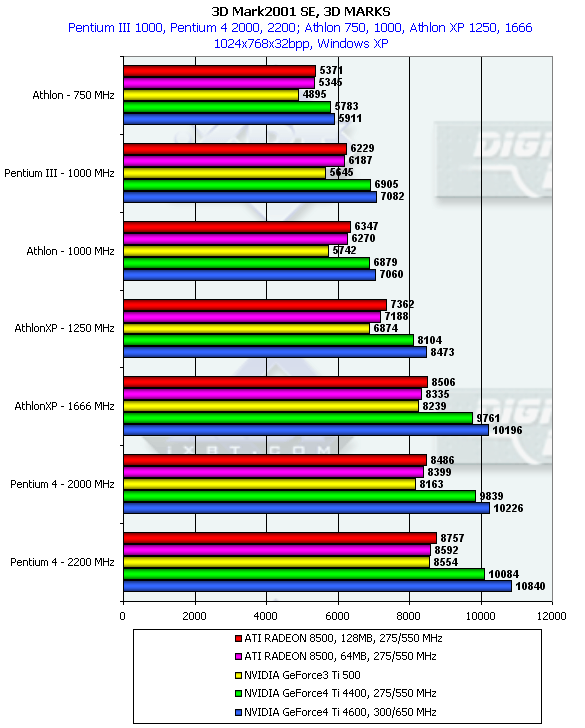
The NVIDIA based cards are more processor-dependent
than ATI's ones. It means that with the more powerful CPU the NVIDIA
cards will perform much better than ATI's ones.
Game1 Low Details
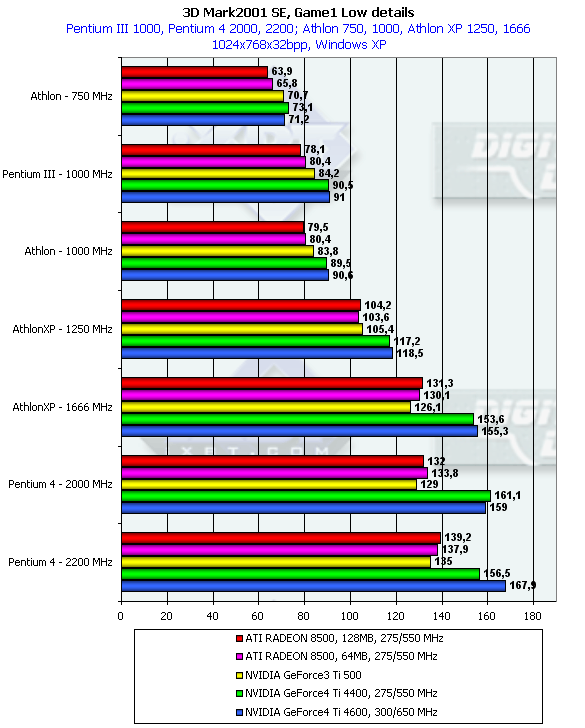
However, this test is exception of the rule I stated
above. The GeForce3 Ti 500 outscores the RADEON 8500 on the junior
processors, when this card fell behind when coupled with a very
powerful one. As for GeForce4 Ti, you can see that it makes no sense
to buy such cards for CPUs less than 1.5 GHz.
Game2 Low Details
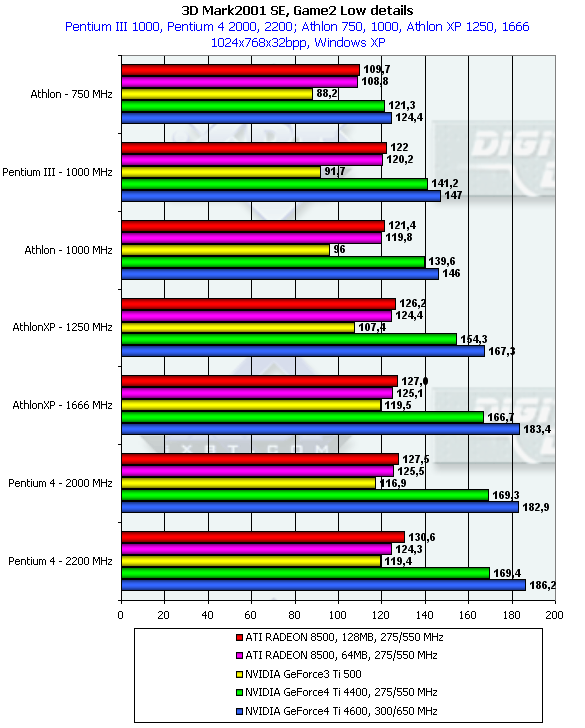
The Game2 is the only modern test which depends
on a 3D accelerator more than on a platform and/or CPU. Look at
the ATI RADEON 8500: when the procesor's power increases its performance
doesn't rise much. The NVIDIA cards are more dependent on the CPU
again.
Game3 Low Details
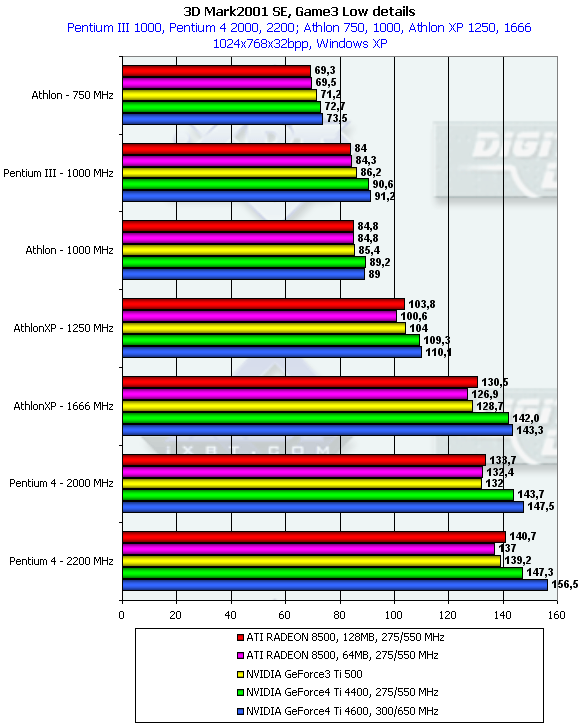
In this test the cards do depend on the processor,
and when its frequency falls down their performance is also decreasing.
Game4
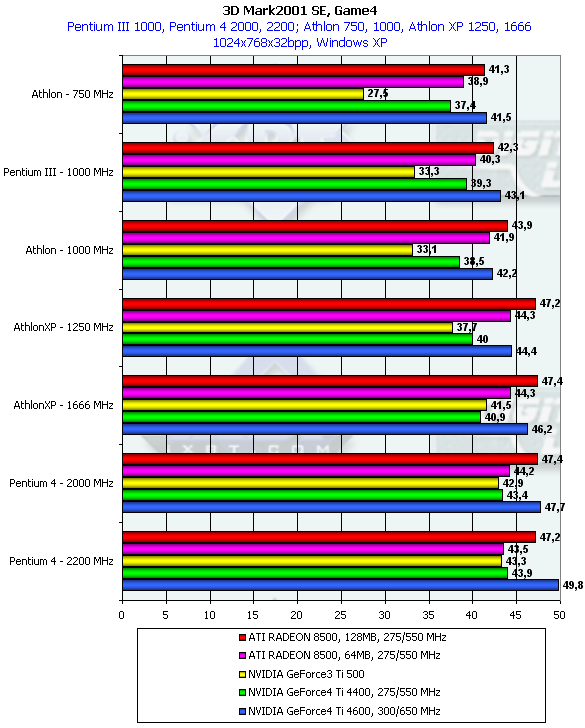
Here the tests depend much both on the accelerator
and on the processor. ATI managed to elevate the performance in
this test. And the RADEON 8500 is almost a leader (especially, the
128 MBytes model). A strong dependence of the GeForce4 Ti 4600 on
the platform and the CPU doesn't allow the card to beat the potentially
weaker RADEON 8500 working on the low-powerful systems. The scalability
of the NVIDIA cards show that they will win on the powerful systems.
1280x1024
3D MARKS
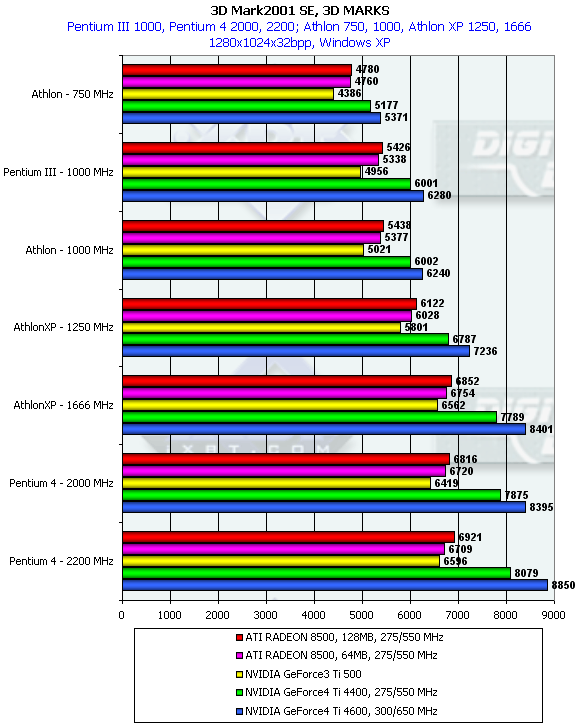
The situation is very close to one at 1024x768,
but there is less difference between the cards on different platforms
because the accelerator is more important here than the platform.
Game1 Low Details
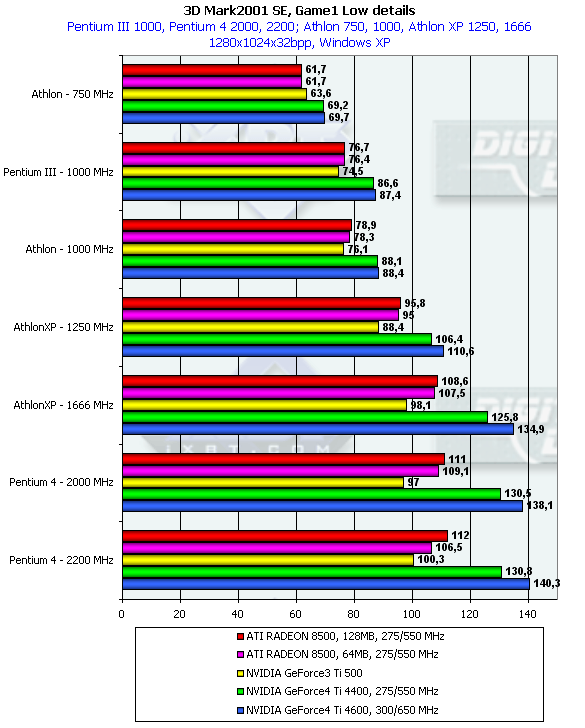
Again we can see that the breakthrough of the GeForce4
ti from its competitors becomes much smaller when it moves to the
1250 MHz CPU and lower.
Game2 Low Details
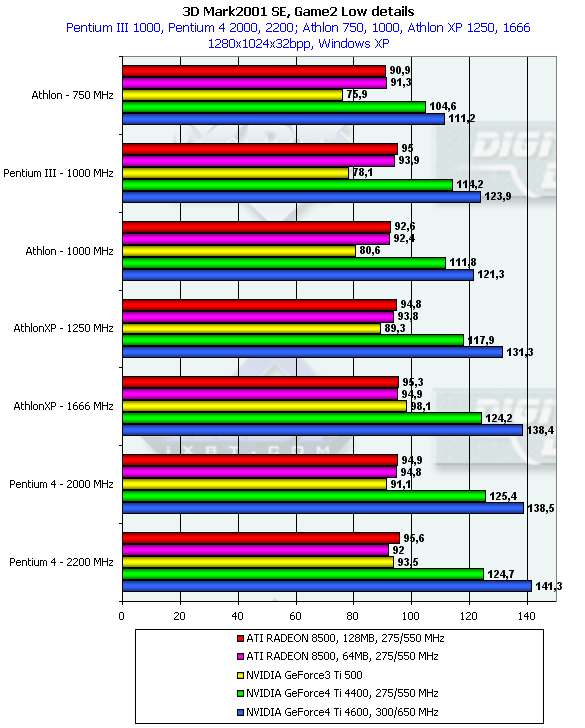
The effectiveness in plane clipping of the GeForce4
Ti and RADEON 8500 gives almost identical results on different platforms.
Game3 Low Details
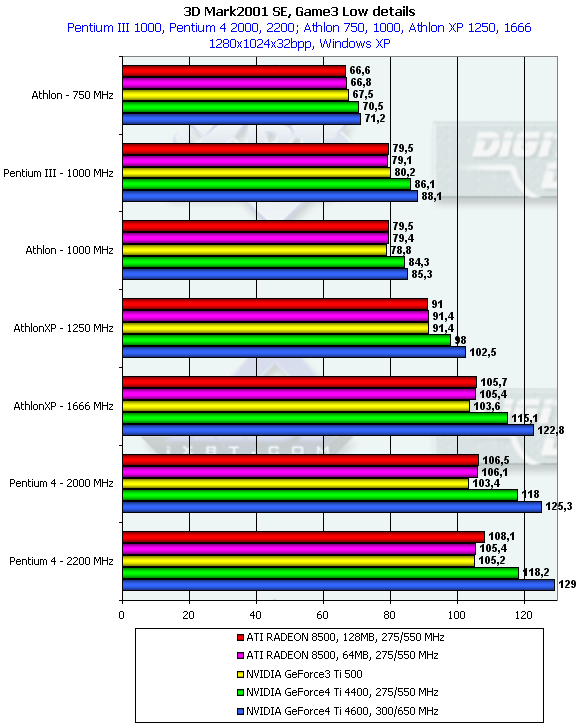
The situation is similar to the Game1.
Game4

At such resolution the performance is limited by
the processor (and the GPU's capabilities, as far as effectiveness
of operation with shaders is concerned). The RADEON 8500 and GeForce4
Ti work stable. I doubt that the RADEON 8500 is exhausted, and that
there is nothing to squeeze from it at a higher CPU speed.
1600x1200
3D MARKS

Only at this resolution on weak processors the
GeForce4 Ti is the most powerful accelerator for today.
Game1 Low Details
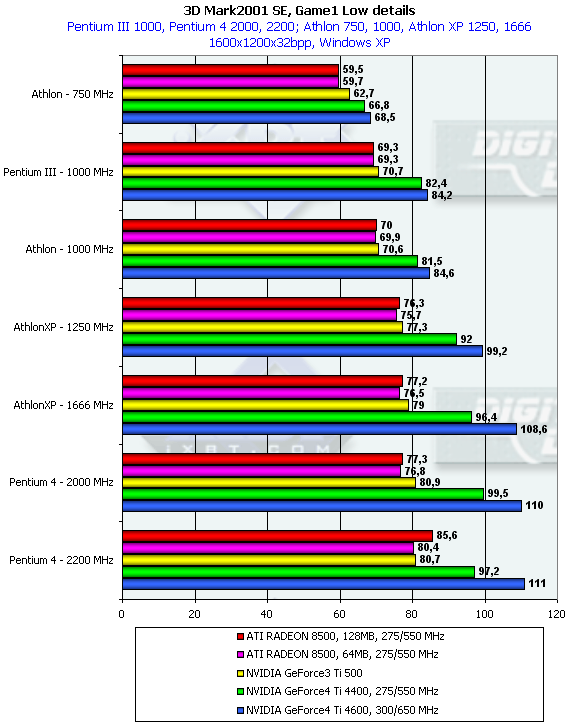
Again this processor-dependent test contradicts
to the general results: the advantage of the GeForce4 Ti is brought
to zero on weak platforms.
Game2 Low Details
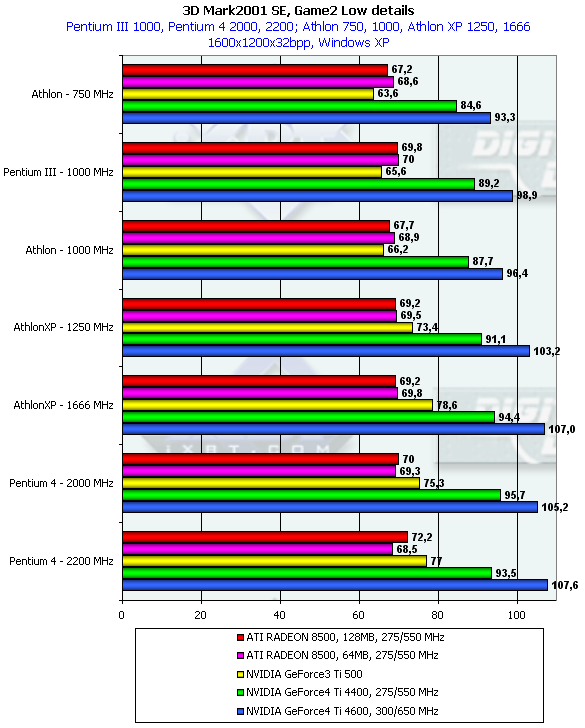
Well, this test neglects processors and platforms
- what it needs is an efficient and powerful accelerator.
Game3 Low Details

The Game3 says that 1600x1200 is enough for low-powerful
processors and platforms to bring down the GeForce4 Ti.
Game4
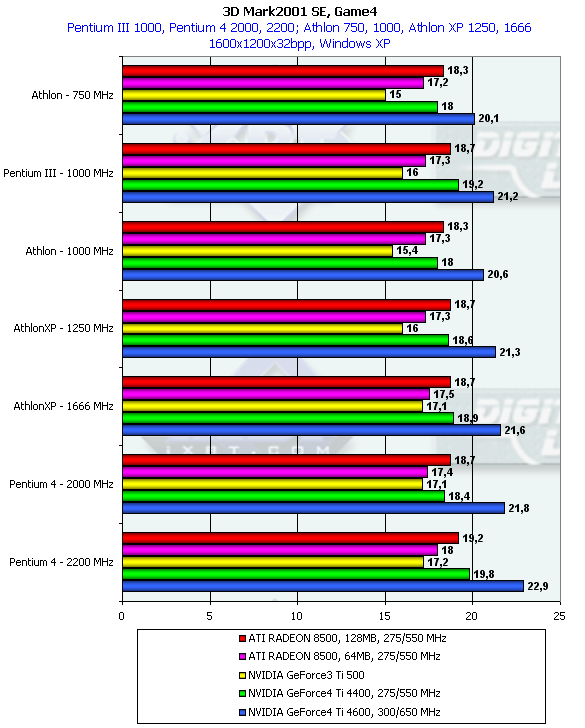
Only in this resolution the GeForce4 Ti shows a
potential for operation with shaders much higher than of the RADEON
8500, when the CPU doesn't affect much.
Conclusion
First of all I want to say again that you shouldn't
use expensive cards on old platforms: a system unit must
be balanced! It's intersting that as the power of a CPU (and a platform)
grows the potential of the NVIDIA's cards remains great, while the
ATI RADEON 8500 based cards have nothing promising.
Although the ASUSTeK's cards are overpriced and
appeared quite late, they have no problems either in quality or
speed. The design of the cards is original; besides, they comply
with all necessary standards and meet all requirements of GeForce4
Ti based cards.
The complete characteristics of video cards of
this and other classes can be found in our 3Digest.
Highs:
- Excellent performance in modern 3D games;
- High quality of the tested samples;
- Original design and color of the cards and their coolers;
- Nice overclockability;
- TV-out;
- Good sets of accessories (including games).
Lows:
Write a comment below. No registration needed!
